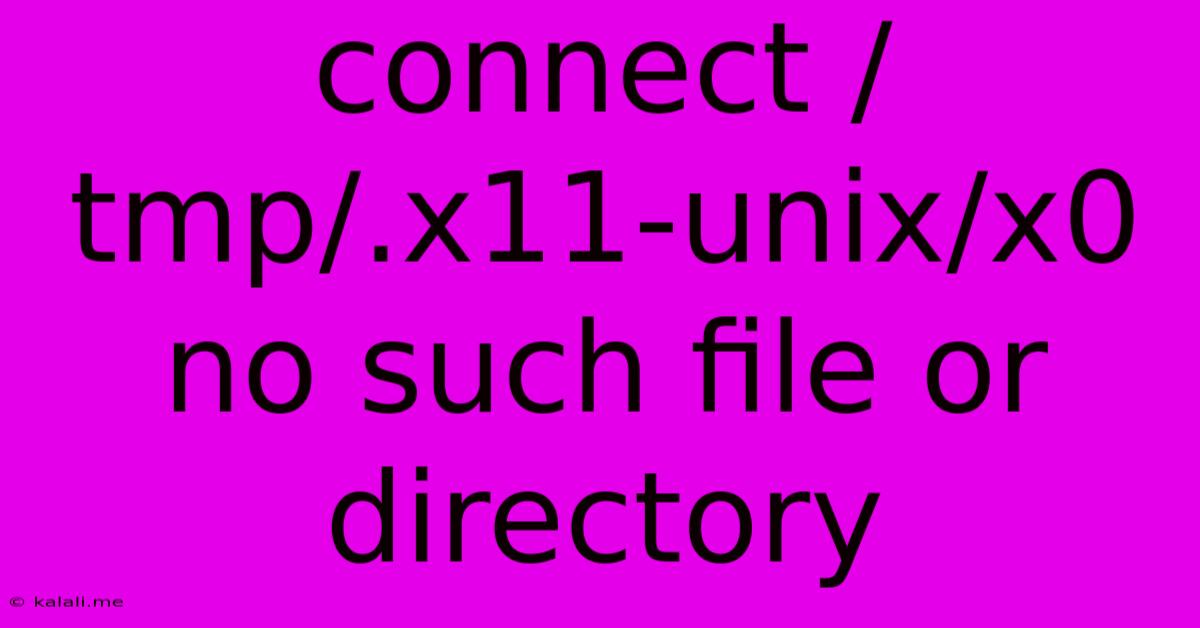Connect /tmp/.x11-unix/x0 No Such File Or Directory
Kalali
May 31, 2025 · 4 min read

Table of Contents
Connecting to X Server: Troubleshooting the "/tmp/.X11-unix/X0: No such file or directory" Error
The error message "/tmp/.X11-unix/X0: No such file or directory" typically arises when attempting to connect to an X server, often encountered during remote desktop connections or when running graphical applications from a command line. This indicates that the system can't find the socket file necessary for the connection. This comprehensive guide will explore the common causes and provide effective solutions to resolve this frustrating issue.
Understanding the Error:
The X Window System (X11) uses a socket file located at /tmp/.X11-unix/X0 (or a similar path with a different number) to handle communication between the X server and client applications. When this file isn't present or accessible, the connection attempt fails, resulting in the error. This often manifests when attempting to use x11vnc, ssh -X, or other tools needing graphical access.
Common Causes and Solutions:
Here's a breakdown of the most frequent causes and the steps to take to remedy them:
1. X Server Not Running: The Most Common Culprit
The most probable reason is that the X server itself isn't running on the remote machine. Without an active X server, the socket file won't exist.
- Verification: Check if the display manager (e.g., GDM, LightDM, KDM) is running. You can usually do this with a command like
ps aux | grep gdm(replacegdmwith your display manager if different). If it's not running, start it. - Solution: Restart the display manager or the entire system. This is usually the quickest fix.
2. Incorrect Permissions or Ownership: Access Denied
The /tmp/.X11-unix directory and its contents might have incorrect permissions, preventing access.
- Verification: Check the permissions using
ls -l /tmp/.X11-unix. Ensure the socket file has appropriate permissions for the user trying to connect. - Solution: If the permissions are overly restrictive, you might need to adjust them (use caution! incorrect permissions can pose security risks). However, restarting the X server often automatically corrects this.
3. Temporary Files and Directory Issues: Cleaning Up
Temporary files can sometimes interfere with the proper creation or access to the socket file.
- Verification: Inspect the
/tmpdirectory for unusual files or excessive clutter. - Solution: Clean up the
/tmpdirectory. You can safely remove most files within it, as they're usually temporary. Use caution; avoid removing system-critical files. A simplerm -rf /tmp/*(executed as root) will remove most files, but only do this if you are very comfortable with the command line. Consider a safer approach like using the graphical file manager to delete the contents of/tmpif you're less familiar with the command line.
4. Firewall Interference: Blocking Connections
A firewall on the remote machine could be blocking the necessary connections.
- Verification: Check your firewall settings (e.g.,
firewalld,iptables) to ensure that connections on the X11 ports (usually around port 6000) are allowed. - Solution: Temporarily disable the firewall to test if this is the issue. If it resolves the problem, configure your firewall to permit the required ports.
5. Incorrect DISPLAY Variable: Misconfiguration
The DISPLAY environment variable specifies the X server to connect to. An incorrect setting can prevent connection.
- Verification: Check the value of the
DISPLAYvariable usingecho $DISPLAY. It should be in the format:0.0or similar, reflecting the correct display. - Solution: Correct the
DISPLAYvariable if it's set incorrectly. Usually, the system will automatically set this correctly, but if you're using a custom setup, double-check its configuration.
6. X Server Configuration Issues: Deeper Problems
Rarely, the problem lies within the X server's configuration itself. This is less common and requires more advanced troubleshooting.
- Verification: This requires examining X server log files and system configurations, which vary considerably depending on your distribution.
- Solution: Consulting your Linux distribution's documentation or seeking assistance from more advanced users may be necessary.
Preventive Measures:
- Regular system updates: Keep your operating system and packages up-to-date.
- Regular
/tmpcleanup: Periodically clear out the/tmpdirectory to prevent file clutter. - Firewall monitoring: Regularly review your firewall settings to ensure proper network access.
By systematically checking these points, you should be able to pinpoint the root cause of the "/tmp/.X11-unix/X0: No such file or directory" error and successfully establish your X server connection. Remember to always exercise caution when modifying system files and permissions. If you're unsure, seeking help from experienced Linux users is advisable.
Latest Posts
Latest Posts
-
Inverse Of Positive Matrix Returning Negative Values
Jun 02, 2025
-
How To Fix A Stuck Drawer
Jun 02, 2025
-
How To Treat Mold On Drywall
Jun 02, 2025
-
Extending Deck Without All New Joists
Jun 02, 2025
-
V 2 V0 2 2a X X0
Jun 02, 2025
Related Post
Thank you for visiting our website which covers about Connect /tmp/.x11-unix/x0 No Such File Or Directory . We hope the information provided has been useful to you. Feel free to contact us if you have any questions or need further assistance. See you next time and don't miss to bookmark.